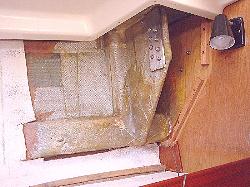Sometime in late 1974 or 1975 Pearson issued a recall to address these problems in the original chainplate configuration on hulls up to about #89. The recall authorized owners to have additional reinforcing added to chainplate knee structure at Pearson's expense. The notice identified the hull deformation as a cosmetic problem but failure in the form of separation of the knee (and almost dismasting) occurred on at least one 10M while racing. In the recall notice Pearson specified a lay-up schedule and the materials to be used. A complete revision of the chainplate design was made starting sometime after hull #101. Pearson may have added additional reinforcing to hulls after the recall but before the design change before they left the factory.
The re-designed chainplate configuration utilizes the main bulkhead as a structural member to dissipate the high stresses into a larger area of the hull. A substantial aluminum I beam bridges the space from chainplate to bulkhead. The bulkhead was made thicker and more tabbing to the hull was added.
One 10M owner has manufactured chainplate beam mountings similar to later model 10M's. At least three of the older boats have these aftermarket I beams. Installation of I beams requires substantial strengthening of main bulkheads. However, the modification is very worthwhile as there are no known chainplate failures on any boats equipped with I beams. See more on the web site.
I-Beam manufacturer:
Graham Bryan. 10 Tommys Lane, Norwalk. CT 06850.
website: www.grahambryan.net
e-mail: graham@grahambryan.net
More... Click here for a more detailed description of the chainplate issue and the chainplate beam re-fit with more photos.

Dimpling of topsides

OEM Chainplate Knee

OEM Chainplate Beam